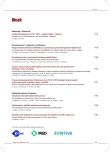Impact of pandemic H1N1 2009 influenza virus on critical care in Australia: A single centre case series
Authors:
N. Kloth; L. Weisbrodt; A. Mclean; M. Nalos
Authors‘ workplace:
Department of Intensive Care Medicine, University of Sydney, Nepean Hospital, Austrálie, přednosta prof. Anthony S. McLean, MD, FRACP, FJFICM
Published in:
Vnitř Lék 2009; 55(12): 1141-1144
Category:
Original Contributions
Overview
Introduction:
In late May 2009, an outbreak of the novel swine – influenza A virus (H1N1) was identified in the Southern hemisphere. We describe the clinical and epidemiologic characteristics of patients infected with H1N1 requiring intensive care (ICU) admission at a Sydney University Hospital. Methods: We retrospectively reviewed medical charts and laboratory results of all patients who tested positively for H1N1 by viral polymerase chain reaction (PCR) on nasopharyngeal smear or endobronchial secretions. Results: From June 1st until August 31st, 2009 a total of 17 patients required admission to the Intensive Care Unit at Nepean Hospital, a tertiary teaching hospital. There were 9 males and 8 females with a mean age of 42 years. The majority of patients were admitted to the ICU within 48 hours of hospital presentation. All patients had flu like symptoms and most presented with respiratory distress and tachycardia. More than half of patients had patchy alveolar infiltrates on chest X ray. Patients who developed acute lung injury and acute respiratory distress syndrome (ALI/ ARDS) typically presented with normal leukocyte count, lymphopenia, raised C‑ reactive protein, creatinkinase, transaminases but normal urea and creatinine. Fourteen patients required intubation while two received non‑invasive ventilation. Several patients tested negative for H1N1 on nasopharyngeal smear PCR but tested positive on endobronchial secretions and the rapid flu antigen test proved unreliable. Two patients died during hospital admission but neither from respiratory failure or its consequences. The median duration of intensive care stay was 12 days while hospital stay was 18 days. Discussion: The Nepean Hospital’s patient profile and outcomes are similar to the data for all H1N1 associated ICU admission in Australia and New Zealand. H1N1 is capable of causing severe respiratory infection especially in the young to middle aged and the impact on intensive care units is disproportionate to seasonal flu. To reliably test for H1N1 in intubated patients we recommend performing viral PCR on endobronchial secretions.
Key words:
flu A – critically ill – H1N1 influenza – viral pneumonia
Sources
1. ANZIC Influenza Investigators. Critical Care Services and 2009 H1N1 Influenza in Australia and New Zealand. New Engl J Med 2009; 361: 1– 10.
2. Perez- Padilla R, de la Rosa- Zamboni D, Ponce de Leon S et al. Pneumonia and Respiratory Failure from Swine- Origin Influenza A (H1N1) in Mexico. N Engl J Med 2009; 361: 680– 689.
3. Kumar A, Zarychanski R, Pinto R et al. Critically Ill Patients with 2009 Influenza A (H1N1) Infection in Canada. JAMA 2009; 302: E1– E8.
Labels
Diabetology Endocrinology Internal medicineArticle was published in
Internal Medicine

2009 Issue 12
Most read in this issue
- Pre‑eclampsia from the perspective of inter- professional collaboration
- The programme of managed ambulatory rehabilitation for patients after heart valve defect surgery
- The complexity of interactions of the tumour growth process
- Symmetrical phlebothrombosis of lower extremities resulting from congenital malformation of vena cava inferior
